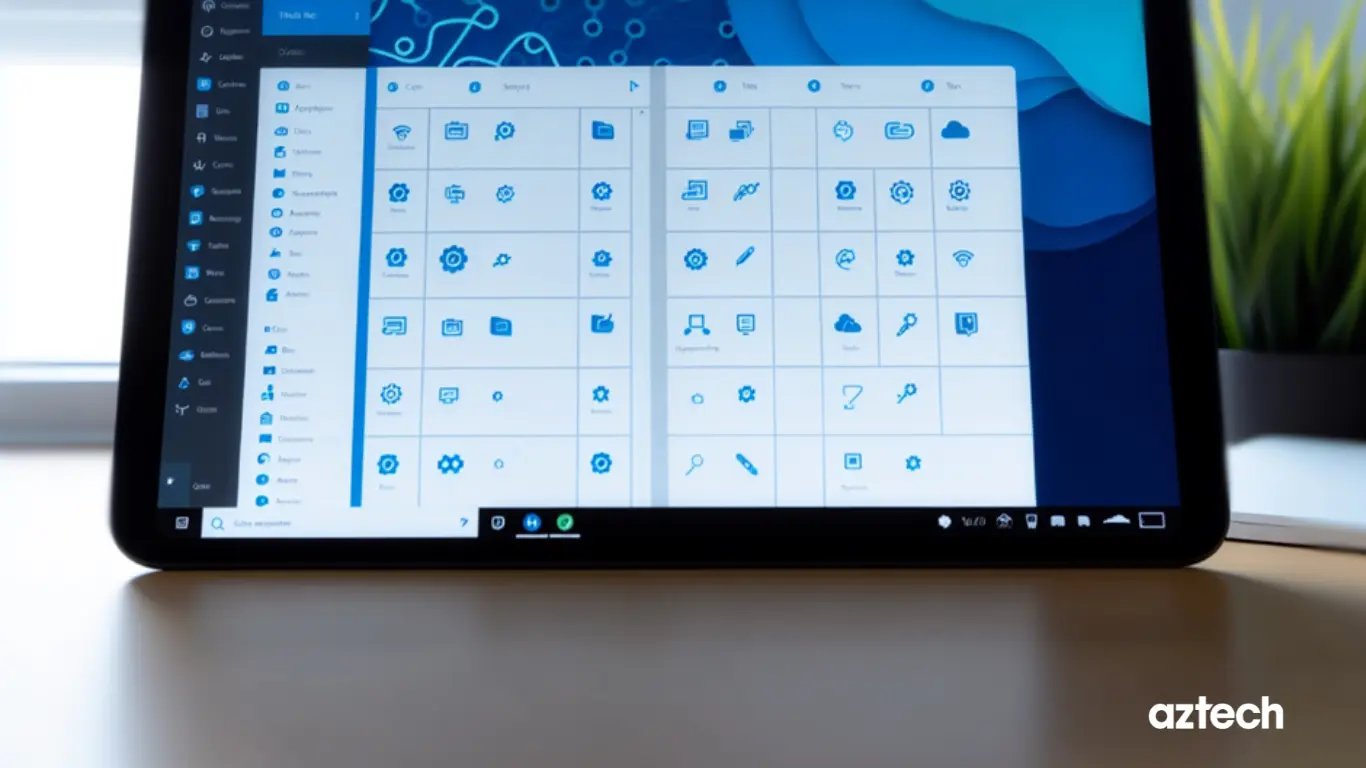At its core, what is Microsoft Azure? It is a comprehensive cloud computing platform that enables businesses to build, deploy, and manage applications through Microsoft’s global network of data centres.
By providing a wide array of services such as computing power, storage options, and networking capabilities, Azure simplifies the digital transformation of companies across various industries.
In our exploration, we’ll delve into Azure’s multifaceted ecosystem, examining the specifics of its offerings and illustrating its role in harnessing the power of cloud technology.
Key Takeaways
- Formerly known as Windows Azure, Microsoft Azure is a robust cloud platform offering a variety of over 200 services including AI, data management, and infrastructure, that support IaaS, PaaS, and SaaS models to foster innovation and efficiency in businesses.
- Azure provides a user-friendly management portal and supports hybrid cloud strategies and industry-specific solutions, enabling flexible, secure, and tailored infrastructure for businesses ranging from finance to healthcare.
- Azure services emphasise security with advanced measures, offer a flexible pay-as-you-go pricing model, and maintain a vast global network of data centres, enhancing performance and service accessibility for users worldwide.
Exploring Microsoft Azure: A Comprehensive Cloud Platform
 Illustration of cloud computing services
Illustration of cloud computing servicesPicture a toolbox. A toolbox full of cutting-edge tools, each designed to create, innovate, and solve challenges. This is Microsoft Azure – a toolbox in the cloud.
As one of the leading cloud providers, Azure offers a broad spectrum of services and solutions, designed to help businesses of all sizes break new ground, save costs, and work more efficiently.
This comprehensive cloud platform offers over 200 cloud services, including Platform as a Service (PaaS), Software as a Service (SaaS), and Infrastructure as a Service (IaaS).
From AI Anomaly Detector to Azure AI Bot Service, Azure Databricks to Azure Machine Learning, and Azure Open Datasets to Azure AI Services, Azure’s solutions span across various domains, making digital operations comprehensive and flexible.
The Core Components of Azure
Azure’s core components are like the three pillars that support a grand structure. These pillars, namely compute, network, and storage, form the foundation for various services, prominently Infrastructure as a Service (IaaS).
The compute component, as the name suggests, is about hosting your application’s resources. It’s like creating virtual machines (VMs) with the specific resources you need. This is crucial for IaaS, as it allows running virtual desktops and servers on-demand.
The network component, on the other hand, is the traffic controller. It manages communication between Azure services, resources, and users, ensuring the secure and efficient operation of services on the platform.
The storage component is your secure vault in the cloud. It provides scalable, durable, and highly available storage solutions for virtual machines and other services, making it an indispensable part of IaaS.
Diverse Solutions Under the Azure Umbrella
Azure isn’t a one-size-fits-all solution. It’s a versatile cloud platform that offers diverse solutions tailored to different industries. Azure understands the unique challenges and requirements of various sectors and provides solutions designed to overcome these hurdles.
Azure’s tailored solutions cater to a range of industries including finance, legal, manufacturers, construction, technology, education, charities, retail, and healthcare.
For instance, Azure helps the finance sector by offering cloud-based financial services software, helping financial organisations modernise their systems and ensure compliance.
For retail businesses, Azure provides intelligent solutions to gain consumer insights and develop personalised experiences for customers.
Navigating the Azure Portal: Your Gateway to Cloud Management
 Image of the Azure portal interface
Image of the Azure portal interfaceImagine the Azure portal as your cockpit, your command centre from where you manage your applications, computing services, and cloud infrastructure. It’s a user-friendly interface that provides a single point of interaction with the cloud platform.
The Azure portal facilitates the creation, management, and monitoring of cloud services, analytics, storage, and application deployment. Using Azure Managed Applications, applications can be created, deployed, and run via the Marketplace or Service Catalogue.
Additionally, the portal features the Azure Resource Manager (ARM) - a central hub for managing and monitoring all apps and services in Microsoft Azure. This visual approach allows efficient cloud management, reducing reliance on command-line tools.
The Role of Azure in Digital Transformation
Digital transformation isn’t just a buzzword. It’s the driving force behind the modernisation of businesses, and Azure plays a pivotal role in this transformation. Azure enables businesses to adopt hybrid cloud strategies and provides industry-specific solutions, enhancing flexibility and efficiency.
Offering a fusion of the public cloud’s flexibility and cost-effectiveness with the control over sensitive data and workloads in the private cloud or on-premises, Azure’s hybrid cloud strategies form a unified, flexible IT setup. This setup supports businesses to run and manage applications across multiple clouds, on-premises, and at the edge, utilising tools, and frameworks best suited for them.
Additionally, Azure leverages industry knowledge and technical capabilities to create specific solutions for industries like retail, finance, and healthcare, aiding their digital transformation journey.
Hybrid Cloud Strategies with Azure
Hybrid cloud strategies have become a cornerstone in the architecture of modern IT solutions. Azure’s support for hybrid cloud strategies allows organisations to combine on-premises and cloud resources for optimal performance and flexibility.
Azure’s hybrid cloud strategy allows businesses to reap the benefits of both public and private clouds.
It offers:
- Scalability and cost-efficiency of the public cloud
- Control over sensitive data and workloads on-premises or in a private cloud
- Unified, flexible IT setup
- Enhanced comprehensiveness and flexibility of digital operations
- Easy building of multi-cloud and hybrid solutions
- Simplified hybrid strategies
- Support for customer operations that can’t use the public cloud
- Easy data movement
- Secure hybrid networks
- Enterprise-level ownership
Tailored Industry Solutions
Azure’s industry-specific solutions are like tailor-made suits, designed to fit the unique needs and challenges of different industries. Azure combines its vast range of services with industry knowledge to create solutions that address the specific requirements of various sectors.
Azure offers customised computing architectures for the financial services industry, ensuring efficient and reliable solutions, adherence to regulatory requirements, and secure and scalable solutions for the banking industry.
For the manufacturing sector, Azure enables the creation of smart factories and resilient supply chains, driving workforce transformation and fostering innovation.
In the retail sector, Azure provides architectures for efficient operations and smart technology for customer engagement, preparing the way for the future of smart retail.
Virtual Machines and Scalable Computing in Azure
 Illustration of virtual machines and scalable computing in Azure
Illustration of virtual machines and scalable computing in AzureVirtual machines and scalable computing are the powerhouses of cloud computing, and Azure provides a robust public cloud computing platform for both. These services enable businesses to develop and deploy web and mobile applications with ease, providing the flexibility and scalability crucial for business growth.
Azure’s virtual machines provide the benefit of virtualisation without the hassle of managing the physical hardware required to run a virtual machine.
On the other hand, Azure tackles scalable computing by offering compute and storage capabilities that can be accessed as needed to support, expand, and manage web applications and services.
Azure ensures that virtual machines can scale according to demand, adjusting based on CPU usage, memory demand, or disk access.
Developing and Deploying Web Apps
The world of web apps is vast and growing, and Azure provides a solid foundation for developing and deploying web applications. With a range of tools and services, Azure simplifies and streamlines the process of building and launching web applications.
Azure offers a variety of tools like Visual Studio for building web apps and supports multiple programming languages and frameworks like ASP.NET, Java, Node.js, Python, and more.
The process of developing and deploying a web application on Azure involves creating a website, deploying the web app through Azure App Service, and publishing the web app using tools like Visual Studio Code or the Azure portal.
Azure’s Microsoft Azure services, like Code-to-Cloud and Azure App Service, streamline the process, making it user-friendly to take your apps from development to production on cloud platforms, with Azure being a reliable cloud provider.
Powering Mobile Apps with Azure Backend Services
In the era of smartphones and tablets, mobile apps are the new frontier for businesses. Azure powers these mobile apps with backend services like Azure Cosmos DB, ensuring seamless performance and scalability.
Azure Backend Services for mobile apps, also known as Mobile App Services or Mobile Backend as a Service (MBaaS), provide cloud services, tools, and DevOps to build engaging cross-platform and native apps for iOS, Android, Windows, or Mac.
Azure’s Backend Services offer features like:
- Continuous integration and delivery
- Real device testing
- Distribution of builds to testers
- App usage monitoring
- Authentication with various providers
- Automatic scaling
- Continuous deployment
- Integration with other Azure services
Developers have the flexibility to code functions directly in the Azure portal or set up continuous integration and deployment pipelines.
Securing Assets with Azure's Robust Security Measures
 Image of Azure's data protection and compliance features
Image of Azure's data protection and compliance featuresIn today’s digital landscape, security is paramount. Azure ensures robust security measures, protecting assets and data with advanced compliance and data protection features.
Azure takes data protection and compliance seriously. Here are some of the measures it takes:
- Encrypts data at rest with 256-bit AES encryption
- Meets FIPS 140-2 compliance
- Keeps data separate
- Has backups
- Follows privacy laws like GDPR
To keep data breaches at bay, Azure offers the following security measures:
- Uses third-party solutions to monitor any unauthorised transfer of sensitive info
- Encrypts data as per customer standards
- Offers cloud-based solutions for classifying, labelling, and protecting documents and emails.
Compliance and Data Protection
When it comes to cloud computing, compliance and data protection are non-negotiable. Azure adheres to strict compliance standards and offers data protection services to safeguard sensitive information.
Azure follows various compliance standards and ensures to stick to strict security and compliance protocols to stay in line with legal and regulatory requirements. To ensure data safety, Azure uses:
- Advanced encryption
- Data segregation
- Redundancy
- Secure data destruction practices
These measures are designed to ensure that customer data stays confidential, intact, and available.
Understanding Azure Pricing and Cost Management
When it comes to cloud services, understanding pricing and managing costs effectively is crucial. Azure offers a flexible pricing model and provides tools for effective cost management.
Azure’s pay-as-you-go pricing model allows you to set up an Azure account and buy cloud services as per your needs. You get a certain number of specific services for free each month, and you only pay for any additional usage beyond that.
To help manage costs, Azure provides tools like Azure Cost Management and CloudZero, which help monitor, allocate, and optimise cloud costs.
You can calculate the pricing of Azure services here at Azure Pricing Calculator from Microsoft.
Azure's Global Presence: Data Centres and Regions
 Illustration of Azure's global data centres and regions
Illustration of Azure's global data centres and regionsIn today’s interconnected world, a global presence is a must for any cloud service provider. Azure’s global presence, with data centres and regions strategically located, serves millions of users worldwide.
With more than 200 physical data centres spread out across the world, Azure’s global presence is substantial. These data centres are strategically located in places like Qatar Central, South Africa North, and UAE, among others. The strategic location of Azure data centres is crucial in ensuring optimal performance and accessibility of services.
The choice of data centre region is key to getting the best performance and accessing the services one needs.
Real-World Applications: How Organisations Utilise Azure
The proof of the pudding is in the eating! Real-world applications of Azure provide a testament to its capabilities and benefits. Organisations utilise Azure for various applications, including disaster recovery, business continuity, and big data analytics.
Providing comprehensive solutions for disaster recovery and business continuity, Azure ensures data protection and minimal downtime during disruptions. It also facilitates big data and analytics processing with robust tools and services for data-driven insights.
With Azure’s robust infrastructure, businesses can harness the power of the cloud to navigate the challenges of the digital landscape and achieve their goals.
|
Read More: Business Continuity vs Disaster Recovery: What’s the difference? |
Disaster Recovery and Business Continuity
Unforeseen disasters can disrupt businesses, but with Azure’s disaster recovery and business continuity solutions, businesses can ensure minimal downtime and seamless continuity.
Azure supports disaster recovery and business continuity efforts with the following features:
- Azure Virtual Desktop for planning BCDR strategies
- An end-to-end backup and disaster recovery solution that is simple, secure, scalable, and cost-effective
- Working with on-premises data protection solutions to ensure data safety during disaster recovery
- Providing a complete backup solution
- Using Azure Files’ redundancy options such as geo-redundancy to safeguard data from service disruptions.
Big Data and Analytics
In the era of big data, businesses need robust solutions to handle and analyse vast amounts of data. Azure’s capabilities in big data and analytics processing empower businesses to extract meaningful insights from their data.
Azure enables businesses to process big data and analytics by offering the following services:
- Azure Synapse Analytics for data warehouses and big data systems
- Azure Stream Analytics for real-time stream processing
- Azure Log Analytics for collecting and analysing data from cloud and on-premises environments.
Azure’s data analytics service offers a comprehensive set of intelligent solutions, including:
- Data warehousing
- Advanced analytics on big data
- Real-time streaming
- Enterprise SQL data warehousing
- Big data analytics
- Data manipulation and analysis of multiple time series
- Enterprise-grade data modelling
Seamless Cloud Migration with Azure Support
Cloud migration can seem daunting, but with Azure’s support, businesses can transition from on-premises infrastructure to the cloud with minimal disruption.
Providing seamless cloud migration support, Azure assists businesses in transitioning from on-premises infrastructure to the cloud.
Tools such as Azure Migrate are available to evaluate on-premises resources and devise a detailed migration plan. Azure also offers resources and tools for every step of the migration process and provides technical and business planning support.
Azure ensures smooth cloud migration by using Azure Site Recovery to fail over VMs to the cloud or between cloud data centres and securing them with network security groups. It also offers cost-effective backup and disaster recovery solutions to keep businesses protected from any disruptions.
|
Read More: How To Migrate To The Cloud Successfully? |
Leveraging Azure for IoT and Edge Computing
In the age of connected devices and real-time data processing, Azure empowers businesses to leverage the Internet of Things (IoT) and edge computing, providing a range of tools and services for these cutting-edge technologies.
Azure aids businesses in managing IoT devices and simplifying edge computing with services like Azure IoT Hub and Azure IoT Edge. These services offer device management features and ease the setup and scaling of edge infrastructure, collaborating with Azure IoT Hub for efficient deployment and management.
For data collection and analysis, Azure leverages Azure Stream Analytics and Azure Data Explorer, providing real-time insights from IoT data.
Summary
As we reach the end of our exploration, it’s clear that Microsoft Azure offers a comprehensive cloud platform, providing a vast array of services and solutions, robust security measures, and seamless cloud migration support. Its capabilities in handling virtual machines and scalable computing, paired with its role in digital transformation, make it a compelling choice for businesses of all sizes.
In the journey to digital transformation, Azure is your reliable companion, offering the tools and support to navigate the digital landscape effectively.
With Azure, businesses can harness the power of the cloud, drive innovation, and achieve their goals.
Isn’t it time you stepped into the cloud computing service with Azure?
Frequently Asked Questions
What is Microsoft Azure used for?
Microsoft Azure is used for public cloud computing, offering Infrastructure as a Service (IaaS), Platform as a Service (PaaS), and Software as a Service (SaaS) solutions for analytics, virtual computing, storage, networking, and more.
What is the difference between Microsoft Cloud and Azure?
The main difference is that Microsoft Azure offers a wider range of capabilities, including infrastructure as a service and platform as a service component, while Microsoft 365 is software as a service product.
Is Microsoft Azure free?
Microsoft Azure is not completely free, but it does offer a free trial that provides access to limited resources for up to 12 months, allowing you to explore the platform.
What is the advantage of Microsoft Azure?
Microsoft Azure offers high availability and redundancy on a global scale, providing businesses with a service level agreement of 99.95%, which is unmatched by most other vendors. This ensures minimal downtime and reliable service for businesses.
What is Microsoft Azure and how does it empower businesses?
Microsoft Azure is a powerful cloud computing platform that offers a wide range of services to help businesses innovate, save costs, and work more efficiently. It provides computing, storage, and analytics solutions for businesses.

-1.png?width=552&height=678&name=text-image%20module%20desktop%20(4)-1.png)


.png?width=2000&name=Case%20study%20(21).png)


-2.png?width=422&height=591&name=text%20image%20tablet%20(31)-2.png)

-2.png?width=1366&height=768&name=Blog%20Hero%20Banners%20(4)-2.png)
-2.png?width=1366&height=768&name=Blog%20Hero%20Banners%20(5)-2.png)




